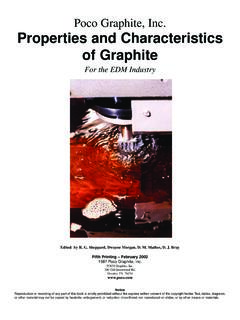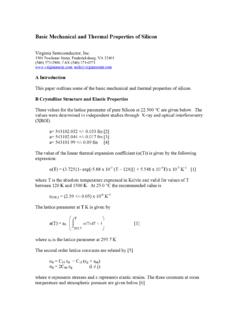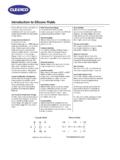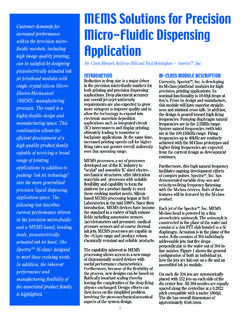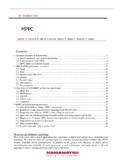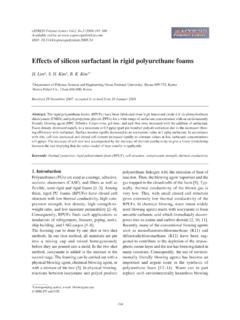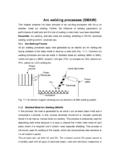Transcription of Poco Graphite, Inc. Properties and Characteristics of ...
1 Edited by A. H. Rashed 2002 Poco Graphite, Graphite, Old Greenwood , TX or recording of any part of this book is strictly prohibited without the express written consent of the copyright holder. Text, tables, diagrams,or other material may not be copied by facsimile, enlargement, or reduction; microfilmed; nor reproduced on slides, or by other means or Graphite, and Characteristics of silicon CarbideProperties and Characteristics of silicon CarbidePREFACEPoco Graphite, Inc. (POCO) perfected a unique, proprietary process for producing silicon carbide that is dif-ferent from conventional silicon carbides, the Properties and Characteristics of which are outlined in this was developed as an alternative solution to the traditional molded silicon carbide s silicon carbide products are produced using a unique manufacturing method. This manufacturingtechnique allows unparalleled flexibility in design without prohibitive costs and lead times. silicon carbideproducts are designed with features to reduce thermal mass while retaining high purpose of this document is to introduce the reader to silicon carbide Properties and to describe testingtechniques, which enable true comparisons between the different manufactured silicon or recording of any part of this book is strictly prohibited without the express written consent of the copyright holder.
2 Text, tables, diagrams,or other material may not be copied by facsimile, enlargement, or reduction; microfilmed; nor reproduced on slides, or by other means or and Characteristics of silicon CarbideReproduction or recording of any part of this book is strictly prohibited without the express written consent of the copyright holder. Text, tables, diagrams,or other material may not be copied by facsimile, enlargement, or reduction; microfilmed; nor reproduced on slides, or by other means or OF CONTENTS pagePrefaceiiTable of ContentsiiiList of FiguresivList of TablesvChapter 1 Introduction The Si-C Production of Fabrication of SiC POCO Process3 Chapter 2 Physical and Chemical Properties of SiC Crystal Density and Chemical Oxidation Resistance8 Chapter 3 Mechanical Properties of SiC Flexural Tensile Strength12 Chapter 4 Thermal Properties of Thermal Thermal Thermal Shock Resistance17 Properties and Characteristics of silicon CarbideReproduction or recording of any part of this book is strictly prohibited without the express written consent of the copyright holder.
3 Text, tables, diagrams,or other material may not be copied by facsimile, enlargement, or reduction; microfilmed; nor reproduced on slides, or by other means or OF Si-C Phase Crystal Structure: (a) Zinc Blend Structure for -SiC and (b) Wurtzite Structure for 6H Flowchart of POCO s SiC Manufacturing Spectrum of SUPERSiC-1 Material Showing -SiC as the Only Detectable Phase Behavior of SUPERSiC-1 Material Showing Weight Gainper Unit Area as a Function of Oxidation Time at 1200 C in Dry Plots for the Flexural Strength of SUPERSiC-1 at Different Plot for the Room Temperature Tensile Strength of SUPERSiC-1 Conductivity of SUPERSiC-1 as a Function of Temperature Calculated from Thermal Diffusivity Measurements (Equations and ). Capacity Measurements of SUPERSiC-1 as Compared to Calculated Data for Pure SiC (Equation ). Order Polynomial Representing the Thermal Expansion of SUPERSiC-1 as a Function of Temperature with the Room Temperature (20 C) as the Reference Order Polynomial Representing the Mean Coefficient of Thermal Expansion of SUPERSiC-1 as a Function of Temperature with the Room Temperature (20 C) as the Reference Shock Resistance of SUPERSiC-1 Determined by the Water Quench and Characteristics of silicon CarbideReproduction or recording of any part of this book is strictly prohibited without the express written consent of the copyright holder.
4 Text, tables, diagrams,or other material may not be copied by facsimile, enlargement, or reduction; microfilmed; nor reproduced on slides, or by other means or OF Elemental Analysis Data (in ppm) of SUPERSiC-1 Material ObtainedUsing GDMS Strength of SUPERSiC-1 and SUPERSiC-2 Grades Measured at Room Temperature Using the Three-Point Bend Strength of SUPERSiC-1 Measured at Different Temperatures Using the Four-Point Bend Test at and Characteristics of silicon CarbideReproduction or recording of any part of this book is strictly prohibited without the express written consent of the copyright holder. Text, tables, diagrams,or other material may not be copied by facsimile, enlargement, or reduction; microfilmed; nor reproduced on slides, or by other means or HistorySilicon carbide (SiC) was accidentally discovered in1890 by Edward G. Acheson, an assistant to ThomasEdison, when he was running an experiment on the syn-thesis of diamonds. Acheson thought the new materialwas a compound of carbon and alumina present in theclay, leading him to name it carborundum, a name that isstill being used on some carbideoccurs naturally in meteorites, though very rarely and invery small the discoverer of SiC,Acheson was the first to synthesize SiC by passing anelectric current through a mixture of clay and , SiC is still produced via a solid state reactionbetween sand ( silicon dioxide) and petroleum coke (car-bon) at very high temperatures in an electric arc the past, the list of ceramics used as industrialmaterials consisted of alumina and other oxides.
5 In recentyears, there have been strong demands for the use ofceramics as structural materials in place of metals andalloys and for use in harsh environments. Consequently,new ceramics such as nitrides, carbides and other cova-lently bonded materials have received increased attentionbecause of their unique The Si-C SystemThe formation of SiC from the reaction between siliconand carbon can take place at temperatures below themelting point of silicon . The phase diagram of the Si-Csystem is shown in Figure It can be seen that SiC isthe only compound of silicon and carbon to occur in thecondensed state in addition to elemental silicon and car-bon. A eutectic point between silicon and SiC exists at1402 C and atom % carbon. The liquidus curvebetween Si and SiC is shown up to 2600 C and 27 atom% C. A peritectic point is located at 2540 C and 27 atom% C under normal are numerous (~200) polytypes for SiC, but onlya few are common.
6 All of the structures may be visualizedas being made up of a single basic unit, a layer of tetra-hedra, in which each silicon atom is tetrahedrally bondedChapter 1 IntroductionFigure The Si-C Phase Diagram ( Elliot, Constitution of Binary Alloys , p. 227,McGraw-Hill, New York, 1965) Properties and Characteristics of silicon CarbideReproduction or recording of any part of this book is strictly prohibited without the express written consent of the copyright holder. Text, tables, diagrams,or other material may not be copied by facsimile, enlargement, or reduction; microfilmed; nor reproduced on slides, or by other means or four carbon atoms and each carbon atom is tetrahe-drally bonded to four silicon differencesamong the existing polytypes are the orientationalsequences by which such layers of tetrahedra arestacked. Successive layers of tetrahedra may be stackedin only one of two ways or orientations but with many pos-sible sequential combinations, each of which represent adifferent crystal common system of nomenclature used to describethe different crystalline polytypes assigns a number cor-responding to the number of layers in the unit cell followedby a letter suffix designating the crystal symmetry; C forcubic, H for hexagonal and R for rhombohedral.
7 Themost common SiC polytypes are the 3C, 4H, 6H, 15R and9T. The cubic 3C is commonly referred to as beta siliconcarbide, -SiC, which has the zinc blend structure, whileall other polytypes are referred to as alpha silicon carbide , -SiC. In general, -SiC phase is mainly 6H, which is awurtzite structure. Figure shows an illustration of thetwo major crystal structures, zinc blend and wurtzite,exhibited by the two SiC phases. Phase transformation ofSiC occurs from -SiC to -SiC upon heating. Undoped -SiC transforms to 6H and 15R above 2000 C, with the15R being a metastable phase that transforms to -SiC with boron lowers the transformation tem-perature and results in the formation of 4H polytype. Onthe other hand, doping with nitrogen prevents the forma-tion of 4H and stabilizes the 6H. The phase trans-formation is irreversible under ambient , under pure nitrogen atmosphere, the transfor-mation can be reversed and -SiC phase can be stabi-lized up to 2500 C by applying a nitrogen atmospheric pressure, silicon carbide does notmelt when heated to elevated temperatures rather, it sub-limes and/or dissociates.
8 In addition, incongruent meltingof SiC was reported at 2829 C under >500 psi pressureof argon and is also possible when it is heated rapidly inan arc-image furnace at atmospheric carbide is considered one of the few light-weight covalently bonded ceramics. The theoretical den-sity of -SiC is only g/cm3and that of -SiC (6 Hpolytype) is g/cm3. Combining it s lightweight and,strong covalency with other Properties , such as low ther-mal expansion coefficient and high thermal conductivity,strength and hardness, make SiC a promising ceramic forthe replacement of conventional metals, alloys and ionic-bonded ceramic Production of SiCThe most common forms of SiC include powders,fibers, whiskers, coatings and single crystals. There areseveral methods to produce SiC depending on the prod-uct form desired and its application. Purity of the productimposes certain restrictions on the selection of themethod of powders are produced predominantly via the tra-ditional Acheson method where a reaction mixture ofgreen petroleum coke and sand is heated to 2500 C usingtwo large graphite electrodes.
9 Due to the high tempera-tures, the Acheson process yields the alpha form of SiC, hexagonal or rhombohedral ( -SiC). The SiC product,usually in the form of a large chunk, is broken, sorted,crushed, milled, and classified into different sizes to yieldthe commercial grades of SiC powder. To produce ultra-fine SiC powder, the finest grade of the Acheson productis further milled, typically for days, and then acid-treatedto remove metallic impurities. Fine SiC powder can alsobe produced using a mixture of fine powders of silica andcarbon reacted at lower temperatures for short periods oftime followed by quenching to prevent grain growth. Theproduct, however, is agglomerates of SiC and needs to beattrition milled to break up the agglomerates and reducethe particle size to submicron range. SiO2powder can bereplaced with SiO ( silicon monoxide) powder which, whenmixed with nano-scale carbon and heated to moderatetemperatures, produces nanocrystalline SiC powder withparticle size in the range 20-100 nm.
10 The SiC particlecharacteristics, such as size, shape and surface chem-istry, are very important for the subsequent densificationprocesses of the SiC powder. For this reason, some postprocesses may be needed, such as the addition of certainelements as sintering aids, to achieve high density duringhot pressing or pressureless fibers are produced via the pyrolysis of organosil-icon polymers, such as polycarbosilane, and are commer-cially available. Briefly, the process consists of melt-spin-ning the polycarbosilane at approximately 300 C, unfus-ing with thermal oxidation at 110-200 C, and baking at1000-1500 C under a flow of inert gas. Nicalon fibers areknown for their excellent mechanical Properties when used as reinforcement in ceramic matrix compositesFigure SiC Crystal Structures: (a) Zinc BlendStructure for -SiC and (b) Wurtzite Structure for 6H -SiC. (From: Kingery et al, Introduction toCeramics , 2nd ed.)
